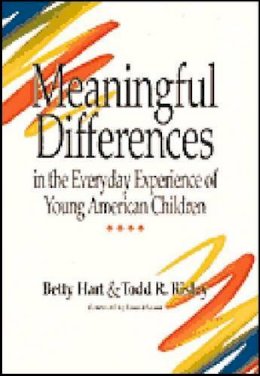
Stock image for illustration purposes only - book cover, edition or condition may vary.
Meaningful Differences in the Everyday Experience of Young American Children
Betty Hart
€ 70.97
FREE Delivery in Ireland
Description for Meaningful Differences in the Everyday Experience of Young American Children
Hardcover. Num Pages: 256 pages, Illustrations. BIC Classification: JFSP1. Category: (G) General (US: Trade). Dimension: 233 x 159 x 20. Weight in Grams: 550.
Meaningful Differences in the Everyday Experience of Young American Children is the story of the landmark research study that uncovered the widely cited "word gap" between children from low-income homes and their more economically advantaged peers. This groundbreaking research has spurred hundreds of studies and programs, including the White House’s Bridging the Word Gap campaign and Too Small to Fail, a joint initiative of the Bill, Hillary, and Chelsea Clinton foundation.
Betty Hart and Todd Risley wanted to know why, despite best efforts in preschool programs to equalize opportunity, children from low-income homes remain well behind their more economically advantaged peers years later in school. Each month, they recorded one full hour of every word spoken at home between parent and child in 42 families, categorized as professional, working class, or welfare families. Two and a half years of coding and analysing every utterance in 1,318 transcripts followed. By age 3, the recorded spoken vocabularies of the children from the professional families were larger than those of the parents in the welfare families. Between professional and welfare parents, there was a difference of almost 300 words spoken per hour. Extrapolating this verbal interaction to four years, a child in a professional family would accumulate experience with almost 45 million words, while an average child in a welfare family would hear just 13 million—coining the phrase the 30 million word gap.
The implications of this painstaking study are staggering: Hart and Risley's follow-up studies at age 9 show that the large differences in children's language experience were tightly linked to large differences in child outcomes. As the authors note in their preface to the 2002 printing of Meaningful Differences, "the most important aspect to evaluate in child care settings for very young children is the amount of talk actually going on, moment by moment, between children and their caregivers." By giving children positive interactions and experiences with adults who take the time to teach vocabulary, oral language concepts, and emergent literacy concepts, children should have a better chance to succeed at school and in the workplace.
Betty Hart and Todd Risley wanted to know why, despite best efforts in preschool programs to equalize opportunity, children from low-income homes remain well behind their more economically advantaged peers years later in school. Each month, they recorded one full hour of every word spoken at home between parent and child in 42 families, categorized as professional, working class, or welfare families. Two and a half years of coding and analysing every utterance in 1,318 transcripts followed. By age 3, the recorded spoken vocabularies of the children from the professional families were larger than those of the parents in the welfare families. Between professional and welfare parents, there was a difference of almost 300 words spoken per hour. Extrapolating this verbal interaction to four years, a child in a professional family would accumulate experience with almost 45 million words, while an average child in a welfare family would hear just 13 million—coining the phrase the 30 million word gap.
The implications of this painstaking study are staggering: Hart and Risley's follow-up studies at age 9 show that the large differences in children's language experience were tightly linked to large differences in child outcomes. As the authors note in their preface to the 2002 printing of Meaningful Differences, "the most important aspect to evaluate in child care settings for very young children is the amount of talk actually going on, moment by moment, between children and their caregivers." By giving children positive interactions and experiences with adults who take the time to teach vocabulary, oral language concepts, and emergent literacy concepts, children should have a better chance to succeed at school and in the workplace.
Product Details
Format
Hardback
Publication date
1995
Publisher
Paul H. Brookes Publishing Co.
Condition
New
Number of Pages
256
Place of Publication
Baltimore, United States
ISBN
9781557661975
SKU
V9781557661975
Shipping Time
Usually ships in 7 to 11 working days
Ref
99-1
Reviews for Meaningful Differences in the Everyday Experience of Young American Children
Most research on intelligence has centred on genetic causes, and has neglected the detailed investigation of possible environmental intermediaries. This very thorough study is a welcome exception; it documents the very unequal way toddlers learn language from their parents, depending on social class and parental intelligence, and deserves very careful study. The book is a model of how environmental factors in intelligence formation should be studied." - Hans.J. Eysenck, Ph.D., D.Sc.
